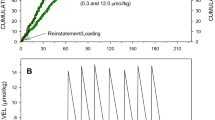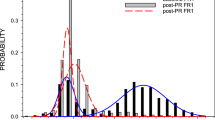Abstract
Rationale
A between-session progressive ratio (BtwPR) procedure was tested in rats responding for cocaine and water reinforcers.
Objectives
Experiment 1 evaluated the sensitivity of the BtwPR procedure to the magnitude of cocaine and water reinforcers. Experiment 2 compared BtwPR performance to within-session progressive ratio (WinPR) performance.
Methods
In experiment 1, rats were tested on a BtwPR procedure with three doses of cocaine (0.1, 0.3, and 1.0 mg/kg/inf) or volumes of water (0.01, 0.03, and 0.1 mL/reinforcer). BtwPR test sessions began with a seeking phase, during which the animal is required to complete a fixed ratio in order to initiate a 2-h consumption phase, where the reinforcer was available according to a fixed ratio 1 (FR1) schedule. Failure to complete the seeking ratio, which was increased after each test session, determined the breakpoint (BP). In experiment 2, the same BtwPR procedure was used except that the consumption phase was a WinPR schedule of reinforcement for cocaine (1.0 mg/kg/inf) or water (0.1 mL) reinforcers.
Results and conclusions
BtwPR BPs increased as a function of the magnitude of both cocaine and water reinforcers. The BtwPR produced smaller BPs than the WinPR for cocaine reinforcers. In contrast, the BtwPR produced larger BPs than the WinPR for water reinforcers. One possible explanation is that priming and response activating effects of the cocaine reinforcer increased the WinPR BP. BtwPR and WinPR procedures may measure different aspects of drug-seeking.




Similar content being viewed by others
References
Belin D, Mar AC, Dalley JW, Robbins TW, Everitt BJ (2008) High impulsivity predicts the switch to compulsive cocaine-taking. Science 320:1352–1355
Belin D, Balado E, Piazza PV, Deroche-Gamonet V (2009) Pattern of intake and drug craving predict the development of cocaine addiction-like behavior in rats. Biol Psychiatry 65:863–868
Christensen CJ, Kohut SJ, Handler S, Silberberg A, Riley AL (2009) Demand for food and cocaine in Fischer and Lewis rats. Behav Neurosci 123:165–171
Czachowski CL, Samson HH (1999) Breakpoint determination and ethanol self-administration using an across-session progressive ratio procedure in the rat. Alcohol Clin Exp Res 23:1580–1586
Czachowski CL, Legg BH, Samson HH (2003) Assessment of sucrose and ethanol reinforcement: the across-session breakpoint procedure. Physiol Behav 78:51–59
de Wit H, Stewart J (1981) Reinstatement of cocaine-reinforced responding in the rat. Psychopharmacology (Berl) 75:134–143
Depoortere RY, Li DH, Lane JD, Emmett-Oglesby MW (1993) Parameters of self-administration of cocaine in rats under a progressive-ratio schedule. Pharmacol Biochem Behav 45:539–548
Economidou D, Pelloux Y, Robbins TW, Dalley JW, Everitt BJ (2009) High impulsivity predicts relapse to cocaine-seeking after punishment-induced abstinence. Biol Psychiatry 65:851–856
Fowler SC, Covington HE 3rd, Miczek KA (2007) Stereotyped and complex motor routines expressed during cocaine self-administration: results from a 24-h binge of unlimited cocaine access in rats. Psychopharmacology (Berl) 192:465–478
Griffiths RR, Bradford LD, Brady JV (1979) Progressive ratio and fixed ratio schedules of cocaine-maintained responding in baboons. Psychopharmacology (Berl) 65:125–136
Hodos W (1961) Progressive ratio as a measure of reward strength. Science 134:943–944
Miller WR (1996) What is a relapse? Fifty ways to leave the wagon. Addiction 91(Suppl):S15–S27
Miller WR, Walters ST, Bennett ME (2001) How effective is alcoholism treatment in the United States? J Stud Alcohol 62:211–220
Norman AB, Tsibulsky VL (2006) The compulsion zone: a pharmacological theory of acquired cocaine self-administration. Brain Res 1116:143–152
Olmstead MC, Parkinson JA, Miles FJ, Everitt BJ, Dickinson A (2000) Cocaine-seeking by rats: regulation, reinforcement and activation. Psychopharmacology (Berl) 152:123–131
Olmstead MC, Lafond MV, Everitt BJ, Dickinson A (2001) Cocaine seeking by rats is a goal-directed action. Behav Neurosci 115:394–402
Pelloux Y, Everitt BJ, Dickinson A (2007) Compulsive drug-seeking by rats under punishment: effects of drug taking history. Psychopharmacology (Berl) 194:127–137
Ranaldi R, Roberts DC (1996) Initiation, maintenance and extinction of cocaine self-administration with and without conditioned reward. Psychopharmacology (Berl) 128:89–96
Richards JB, Mitchell SH, de Wit H, Seiden LS (1997) Determination of discount functions in rats with an adjusting-amount procedure. J Exp Anal Behav 67:353–366
Richardson NR, Roberts DC (1996) Progressive ratio schedules in drug self-administration studies in rats: a method to evaluate reinforcing efficacy. J Neurosci Methods 66:1–11
Roberts DC, Loh EA, Vickers G (1989) Self-administration of cocaine on a progressive ratio schedule in rats: dose-response relationship and effect of haloperidol pretreatment. Psychopharmacology (Berl) 97:535–538
Roberts DC, Morgan D, Liu Y (2007) How to make a rat addicted to cocaine. Prog Neuropsychopharmacol Biol Psychiatry 31:1614–1624
Vanderschuren LJ, Everitt BJ (2004) Drug seeking becomes compulsive after prolonged cocaine self-administration. Science 305:1017–1019
Witkin JM, Goldberg SR (1990) Effects of cocaine on locomotor activity and schedule-controlled behaviors of inbred rat strains. Pharmacol Biochem Behav 37:339–342
Acknowledgements
This work was supported by DA10588 and DA026600 awarded to Jerry B. Richards. This work was also supported by NIAAA T-32-AA007583. We would like to thank Linda Beyley and Lindsey Leonard for their assistance in conducting the experiments and Mark Kogutowski for his technical expertise in computer programming for the current experiments. The cocaine tested in these experiments was gifted by NIDA.
Author information
Authors and Affiliations
Corresponding author
Rights and permissions
About this article
Cite this article
Gancarz, A.M., Kausch, M.A., Lloyd, D.R. et al. Between-session progressive ratio performance in rats responding for cocaine and water reinforcers. Psychopharmacology 222, 215–223 (2012). https://doi.org/10.1007/s00213-012-2637-9
Received:
Accepted:
Published:
Issue Date:
DOI: https://doi.org/10.1007/s00213-012-2637-9




